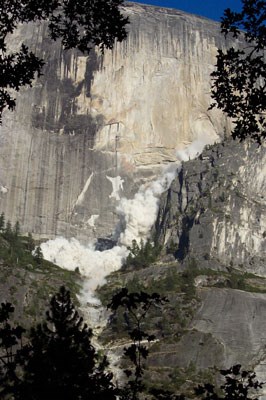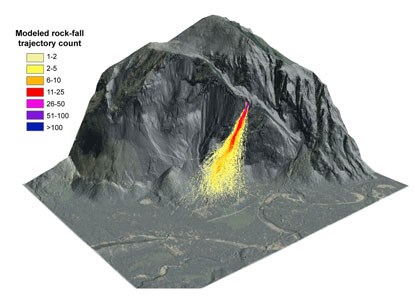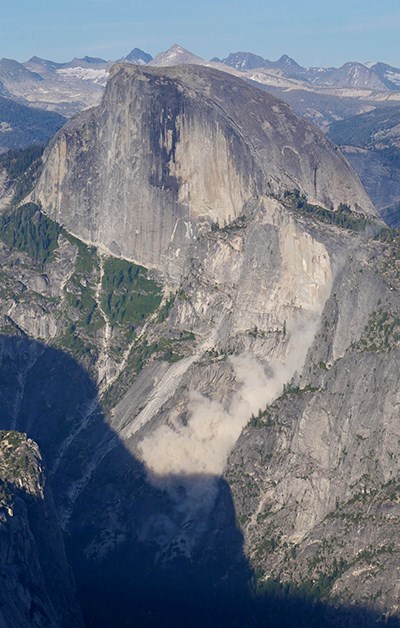
What Is a Rockfall?Rockfalls are a natural and dynamic geologic process involving the detachment and rapid downard movement of rock. Due to its steep, glacier-carved cliffs, Yosemite Valley experiences many rockfalls each year. Historical records indicate that more than 1,000 rockfalls have occurred in the park during the past 150 years. Massive piles of "talus" or rock debris at the base of Yosemite Valley's cliffs are reminders of these dramatic events. Natural processes like rockfall help to create the beautiful and changing scenery in Yosemite National Park, but they also present potential hazards. 
Photo by Amanda Nolan What Causes Rockfall?A number of geologic processes set the stage for rockfalls, including glaciation, weathering, and bedrock fractures. Tectonic stresses and erosion cause granite rock to fracture. Rockfalls later occur along these fractures. Fractures that develop parallel to the surface are called sheeting joints. Sheeting joints create large slabs of rock that ultimately fall away in a process known as exfoliation. In Yosemite Valley, Royal Arches and the face of Half Dome are examples of landforms that have resulted from this process. Over long periods, water flowing through fractures decomposes the bedrock in a process called weathering. Weathering loosens bonds that hold rocks in place. Triggering mechanisms like water, ice, earthquakes, and vegetation growth are among the final forces that cause unstable rocks to fall. If water enters fractures in the bedrock, it can build up pressure behind unstable rocks. Water also may seep into cracks in the rock and freeze, causing those cracks to grow. This process is called "frost wedging" or "freeze-thaw" and can incrementally lever loose rocks away from cliff faces. Recent research suggests that daily temperature variations and extreme heat can also cause rock slabs to become unstable. Ground shaking during earthquakes often triggers rockfalls. Additionally, a variety of vegetation-most notably firs, pines, and canyon live oaks-grow into the sheer rock faces where their roots expand and pry apart joints in the granite. Most rockfalls in Yosemite occur in the winter and early spring, during periods of intense rainfall, snow melt, and/or subfreezing temperatures, but many large rockfalls have also occurred during periods of warm, stable weather. For any given rockfall, there is always a large degree of uncertainty about what exactly triggered it; historical records indicate that more than half of all documented rockfalls in Yosemite were not associated with a recognizable trigger. Predicting actual rockfall events is not yet possible, but understanding the forces that trigger rockfalls is an important step toward this goal. 
How Does Yosemite Address Rockfall?The National Park Service in Yosemite is responding to rockfall in a variety of ways. Park scientists, in collaboration with the U.S. Geological Survey (USGS) and academic researchers, are actively studying rockfalls through the use of new technology, such as high resolution digital photography, laser mapping of cliffs, and exposure dating of boulders. These tools offer vast improvement in resolution from previously available data, allowing geologists to accurately map rockfall zones and to study rockfall source areas. Additionally, new computer modeling technology shows promise in simulating future rockfall behavior. The park is also actively investigating methods for monitoring rockfall activity. The National Park Service has produced a report quantifying rockfall hazard and risk in Yosemite Valley to help improve safety and guide future park-planning efforts: Quantitative rock-fall hazard and risk assessment for Yosemite Valley, Yosemite National Park, California. Based on the results of this study, the National Park Service reduced rockfall-related risk in Yosemite Valley by removing or repurposing high-risk buildings within hazardous areas. These actions reduced rockfall-related risk by 95%. Additionally, park rangers have developed emergency plans for rockfall events, and may close trails and post warning signs in particularly hazardous areas. What Should I do in the Event of a Rockfall?

Morgan Newport Yosemite Rockfall Year in Review: 20242024 was a relatively quiet year for rockfalls in Yosemite, with 42 documented rockfalls and a cumulative volume of 1,397 cubic meters (4,158 tons), both are which are below 20-year averages. Although there wasn’t an obvious “standout” rockfall in 2024, several deserve mention. The largest rockfall of 2024 occurred at 10:23 pm on April 15. Visitors sleeping in the Pines campgrounds were awoken by distant thundering sounds indicative of a rockfall, but the location was unclear. Three days later a wilderness Ranger hiking the seasonally closed section of the John Muir Trail between Nevada Fall and Clark Point encountered literal tons of rock debris on the trail. Approximately 562 cubic meters (1,672 tons) of rock slid from just below the south rim of the canyon, fragmenting into boulders that tumbled across three switchbacks. Hundreds of boulders came to rest on the trail, two areas of the trail sustained deep impact craters, and several fir trees were snapped or toppled by rock impacts. Although the weather was clear at the time, water was observed seeping from the source area, suggesting a snowmelt trigger. The trail was closed for several weeks as boulders were drilled, blasted, and cleared. Rockfalls alter Yosemite’s landscape, sometimes dramatically. At 11:20 am on May 14, a small rockfall occurred from LeConte Gully below Glacier Point, sending boulders down the path of Staircase Falls. The rockfall originated from a narrow granite fin forming the east wall of LeConte Gully that was the source of rockfalls in 2003 and 2007. Part of the fin collapsed, allowing Staircase Creek a more direct path over the cliff, instantly forming a new 150-foot-tall waterfall at the top of Staircase Falls. Two rockfalls affected the Upper Yosemite Falls Trail in 2024. The first occurred at 7:14 am on October 11, when approximately 28 cubic meters (84 tons) of rock fell from the cliff above the traversing section of the trail between Columbia Point and the base of the Upper Falls. Boulders swept across the trail and fell into the Lower Falls Amphitheater below. Fortunately, the early morning timing meant that both that section of trail and the amphitheater were devoid of people. The second rockfall occurred at 2:58 pm on December 26. Approximately 33 cubic meters (98 tons) of rock fell from high on the “Forbidden Wall” above the upper switchbacks, with rock debris tumbling over 20 switchbacks of the trail. One visitor sustained leg injuries but was able to walk out with assistance. In both cases, the trail was closed pending geological assessment. Other significant rockfalls in 2024 occurred from Grizzly Peak, Castle Cliffs, Sentinel Creek, and the Big Oak Flat Road. Also, of note in 2024 was the continued widening of the crack in the cliff west of Royal Arches and north of The Ahwahnee, adjacent to the climbing route “Super Slide.” This crack was about one inch wide when first discovered in August 2023. Monitoring showed that the crack widened in the fall of 2023, narrowed over the winter of 2023-2024, and then widened again to nearly four inches in August 2024. The crack is being monitored closely, and local closures remain in place. If you witness a rockfall of any size or encounter fresh rock debris, please contact park geologist Greg Stock at 209/768-1028 or by email, or contact park dispatch by calling or texting 911 within the park. Documented rockfalls are added to the park database, enabling long-term evaluation of rockfall activity to improve public safety. Learn More
ReferencesReferences: Historical Rockfalls and Case Studies
References: Prehistorical Rockfalls
References: Rockfall Hazard and Risk
References: Methods of Rockfall Characterization
Videos
|
Last updated: November 20, 2025

